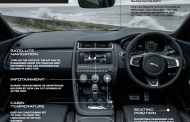Leading interiors supplier International Automotive Components Group has come up with the concept of developing scents and application processes to counteract motion sickness. According to Rose Ryntz, IAC vice president of engineering, advanced development and material engineering who spoke to Automotive News, this could become an important component of future vehicles, especially in the case of autonomous vehicles where passengers could find themselves travelling at fast speeds without necessarily facing forwards in the direction of motion. This dissonance could significantly increase the risk of motion sickness.
IAC is investigating the use of fragrances like ginseng, herbal oils and lavenders for use in the interiors of autonomous vehicles. She said that these scents could be used to counteract motion sickness if they are encapsulated in plastics. However, this is by no means an exact science as the triggers for motion sickness could be different for different individuals.
Ryntz estimated that the use of such aromas could become commercially viable as early as 2030. In the case of automated cars, there is no driver driving the car and with your hands off the steering wheel and plenty of permutations for seating position and direction, chances are higher for motion sickness
IAC specializes in the production of parts like dashboards, consoles and door panels. However, there is still a lot of confusion about how the use of scents can be translated into product design and how they can be incorporated into commercial vehicle materials. Some of the factors that need to be taken into consideration include the direction in which the vehicle and the passenger are facing, the speed at which the vehicle is travelling and the trigger factors for motion sickness. Another challenge is getting people to participate in tests involving the use of plastics in which different scents have been integrated. Getting the scents to last poses another challenge while finding a smell that can work for as many people as possible is also difficult.


















